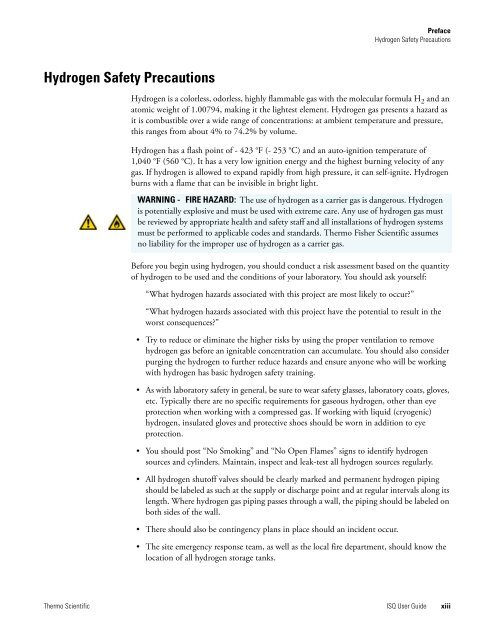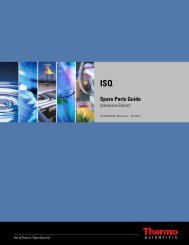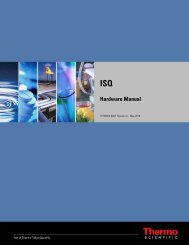ISQ User Guide - Write Frame of Mind
ISQ User Guide - Write Frame of Mind
ISQ User Guide - Write Frame of Mind
Create successful ePaper yourself
Turn your PDF publications into a flip-book with our unique Google optimized e-Paper software.
Hydrogen Safety Precautions<br />
Preface<br />
Hydrogen Safety Precautions<br />
Hydrogen is a colorless, odorless, highly flammable gas with the molecular formula H 2 and an<br />
atomic weight <strong>of</strong> 1.00794, making it the lightest element. Hydrogen gas presents a hazard as<br />
it is combustible over a wide range <strong>of</strong> concentrations: at ambient temperature and pressure,<br />
this ranges from about 4% to 74.2% by volume.<br />
Hydrogen has a flash point <strong>of</strong> - 423 °F (- 253 °C) and an auto-ignition temperature <strong>of</strong><br />
1,040 °F (560 °C). It has a very low ignition energy and the highest burning velocity <strong>of</strong> any<br />
gas. If hydrogen is allowed to expand rapidly from high pressure, it can self-ignite. Hydrogen<br />
burns with a flame that can be invisible in bright light.<br />
WARNING - FIRE HAZARD: The use <strong>of</strong> hydrogen as a carrier gas is dangerous. Hydrogen<br />
is potentially explosive and must be used with extreme care. Any use <strong>of</strong> hydrogen gas must<br />
be reviewed by appropriate health and safety staff and all installations <strong>of</strong> hydrogen systems<br />
must be performed to applicable codes and standards. Thermo Fisher Scientific assumes<br />
no liability for the improper use <strong>of</strong> hydrogen as a carrier gas.<br />
Before you begin using hydrogen, you should conduct a risk assessment based on the quantity<br />
<strong>of</strong> hydrogen to be used and the conditions <strong>of</strong> your laboratory. You should ask yourself:<br />
“What hydrogen hazards associated with this project are most likely to occur?”<br />
“What hydrogen hazards associated with this project have the potential to result in the<br />
worst consequences?”<br />
• Try to reduce or eliminate the higher risks by using the proper ventilation to remove<br />
hydrogen gas before an ignitable concentration can accumulate. You should also consider<br />
purging the hydrogen to further reduce hazards and ensure anyone who will be working<br />
with hydrogen has basic hydrogen safety training.<br />
• As with laboratory safety in general, be sure to wear safety glasses, laboratory coats, gloves,<br />
etc. Typically there are no specific requirements for gaseous hydrogen, other than eye<br />
protection when working with a compressed gas. If working with liquid (cryogenic)<br />
hydrogen, insulated gloves and protective shoes should be worn in addition to eye<br />
protection.<br />
• You should post “No Smoking” and “No Open Flames” signs to identify hydrogen<br />
sources and cylinders. Maintain, inspect and leak-test all hydrogen sources regularly.<br />
• All hydrogen shut<strong>of</strong>f valves should be clearly marked and permanent hydrogen piping<br />
should be labeled as such at the supply or discharge point and at regular intervals along its<br />
length. Where hydrogen gas piping passes through a wall, the piping should be labeled on<br />
both sides <strong>of</strong> the wall.<br />
• There should also be contingency plans in place should an incident occur.<br />
• The site emergency response team, as well as the local fire department, should know the<br />
location <strong>of</strong> all hydrogen storage tanks.<br />
Thermo Scientific <strong>ISQ</strong> <strong>User</strong> <strong>Guide</strong> xiii






